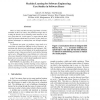Free Online Productivity Tools
i2Speak
i2Symbol
i2OCR
iTex2Img
iWeb2Print
iWeb2Shot
i2Type
iPdf2Split
iPdf2Merge
i2Bopomofo
i2Arabic
i2Style
i2Image
i2PDF
iLatex2Rtf
Sci2ools
ICTAI
2002
IEEE
2002
IEEE
Machine Learning for Software Engineering: Case Studies in Software Reuse
There are many machine learning algorithms currently available. In the 21st century, the problem no longer lies in writing the learner, but in choosing which learners to run on a given data set. In this paper, we argue that the final choice of learners should not be exclusive; in fact, there are distinct advantages in running data sets through multiple learners. To illustrate our point, we perform a case study on a reuse data set using three different styles of learners: association rule, decision tree induction, and treatment. Software reuse is a topic of avid debate in the professional and academic arena; it has proven that it can be both a blessing and a curse. Although there is much debate over where and when reuse should be instituted into a project, our learners found some procedures which should significantly improve the odds of a reuse program succeeding.
Artificial Intelligence | Data Set | ICTAI 2002 | Learners | Reuse |
| Added | 15 Jul 2010 |
| Updated | 15 Jul 2010 |
| Type | Conference |
| Year | 2002 |
| Where | ICTAI |
| Authors | Justin S. Di Stefano, Tim Menzies |
Comments (0)

